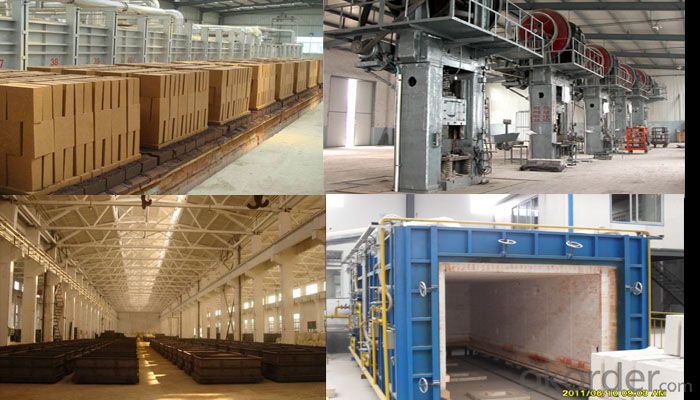Refractory Bricks Light Weight Thermal Ceramic Mullite Insulation
- Loading Port:
- China main port
- Payment Terms:
- TT OR LC
- Min Order Qty:
- 0.02
- Supply Capability:
- 2050 m.t/month
OKorder Service Pledge
OKorder Financial Service
You Might Also Like
Acid Resistant Brick
CMAX firebricks are classified under temperature between 1300℃ to 1700℃, manufactured from high purity alumina clay.
Insulation bricks are classified under temperature between 1300ºC and 1700ºC, manufactured from high purity alumina clay by mixing, press-forming, drying, sintering and machining. Bricks contain carefully-graded organic fillers which are burned out during sintering to give a uniform controllable pore structure. This technique makes product feature low thermal conductivity and excellent heat insulation.
Refractory Insulation brick can be used as a hot face lining directly exposed to the heat or as a backup insulation layer in iron and steel mills, non-ferrous foundries, petrochemical, ceramic, glass, cement and oil fired electric power generating plants.

Features
Light weight and low thermal conductivity allows thinner furnace walls
Maintain stable structural strength throughout ambient to maximum service temperature
Low heat storage results in rapid cooling and heating operation
Low iron and impurities to enhance reducing atmosphere
High thermal shock resistance in preventing spalling
Non standard sizes and shapes are available upon request
Application
Ceramic shuttle kilns
Metal heat treatment furnaces Steel billet reheating furnaces Oil refinery heaters
Laboratory furnaces
Our insulating bricks mainly include fireclay insulating brick, high alumina insulating brick, mullite insulating brick etc.
Data Sheet
Classification Temperature (℉/℃) | 3000/1650 |
Bulk Density (g/cm3 ) | ≤1.0 |
Thermal Conductivity | |
800℃, W/m.K | ≤0.39 |
1000℃, W/m.K | ≤0.43 |
1200℃, W/m.K | ≤0.48 |
Reheating Linear Change (%) | 1550℃×12h |
≤0.9 | |
Chemical Composition (%) | |
Al2O3 | ≥75 |
Fe2O3 | ≤0.5 |
Packaging & Shipping
Packaging Details:Be packed in fumigated wooden pallets
Delivery Detail: 30 days after order

Our Services
Optimum solution and product supply of refractories for high temperature industries, such as iron steel, non-ferrous, petrochemical and building materials.
Engineering design, contract and consult for refractories, and civil architecture design.
Research, development, manufacture and sale of superhard materials.
R&D, manufacture and sale of special packing materials for export.
Inspection, supervision and arbitration of refractories.
Consultation and services in refractories information.
Training and cultivation of high-level talents in refractories profession
Sales Network

Company Information
CNBM (China National Building Material) Group is the largest comprehensive building materials group in China that in integrate scientific research, manufacturing and logistics into one entity. The largest building materials and equipment specialists in China. Upon State Council approval, today CNBM owned more than 300 subordinate manufacturing factories and servicing companies. There are 6 fully owned public listed companies and 11 partially owned with substantial shares public listed companies. In many of these fields, CNBM is playing the leading role in the building industry in the country.


FAQ
1. Which products do you have?
We have all kinds of refractory brick, castable, mortar, cement, ceramic fiber products, etc.
Or you could browse our products to choose what you need.
2. Can you give me a brief introduction of the application of your products?
We are mainly specializing in the refractory materials in iron and steel, cement, glass, ceramics, petrochemical, electric power Industry, etc.
3. If I need your offer, what information do you need?
In order to choose suitable products, it will be appreciated to provide us the information, such us specification, technical data, order quantity, products application etc. If any question, please contact us freely.
- Q: Are insulating fire bricks suitable for use in heat exchangers?
- Yes, insulating fire bricks are suitable for use in heat exchangers. These bricks are designed to withstand high temperatures and provide excellent insulation, making them ideal for heat transfer processes. They are commonly used in various industries, including metallurgy, glass, and ceramic manufacturing, where heat exchangers are essential for efficient heat transfer.
- Q: Is it possible to recycle broken insulating fire bricks?
- Yes, it is possible to recycle broken insulating fire bricks. These bricks can be crushed and used as aggregate in the production of new bricks or other construction materials. Additionally, they can be ground into a fine powder and used as a raw material in the manufacturing of refractory products. Recycling broken insulating fire bricks helps reduce waste and conserve resources.
- Q: Can insulating fire bricks be used in residential applications?
- Residential applications can indeed make use of insulating fire bricks. These bricks are lightweight and possess exceptional thermal insulation properties, rendering them suitable for diverse residential purposes. They find utility in insulating fireplaces, wood-burning stoves, and chimneys, thereby contributing to enhanced energy efficiency and reduced heat loss. Moreover, insulating fire bricks can be employed in the construction of pizza ovens and outdoor grills, ensuring remarkable heat retention and insulation. Their ability to endure high temperatures makes them perfectly suited for such applications. In summary, insulating fire bricks present homeowners with a dependable and long-lasting solution to bolster insulation and heat retention in residential settings.
- Q: Are insulating fire bricks resistant to thermal conductivity?
- Yes, insulating fire bricks are designed to be resistant to thermal conductivity. These bricks are made from materials with low thermal conductivity, such as lightweight refractory fibers or insulating materials like vermiculite or perlite. The purpose of insulating fire bricks is to provide thermal insulation and prevent heat transfer, making them ideal for applications where temperature control is important, such as in kilns, furnaces, or fireplaces. By reducing thermal conductivity, insulating fire bricks help to retain heat within the desired area and minimize energy loss, making them an effective choice for insulation in high-temperature environments.
- Q: Can insulating fire bricks be used in the construction of metal smelting molds?
- Insulating fire bricks are capable of being utilized in the construction of metal smelting molds. Their design allows them to endure high temperatures, rendering them suitable for smelting processes that necessitate extreme heat. These bricks possess remarkable thermal insulation properties, which aid in retaining heat and minimizing heat loss throughout the smelting procedure. This aspect is crucial in upholding a consistent temperature within the mold, ensuring efficient and successful metal smelting. Furthermore, insulating fire bricks are lightweight and easily manageable, making them a practical selection for mold construction. In conclusion, insulating fire bricks are a dependable and efficient choice when it comes to constructing metal smelting molds.
- Q: Can insulating fire bricks be used for fireplace construction?
- Yes, insulating fire bricks can be used for fireplace construction. Insulating fire bricks are designed to withstand high temperatures and provide excellent insulation, making them ideal for lining fireplaces. They help to retain heat, increase the efficiency of the fireplace, and prevent heat loss. Additionally, insulating fire bricks are lightweight, making them easier to handle and install. Overall, using insulating fire bricks for fireplace construction is a practical choice that can enhance the performance and energy efficiency of the fireplace.
- Q: Do insulating fire bricks affect the overall aesthetics of a structure?
- The overall aesthetics of a structure are typically not significantly affected by insulating fire bricks. These bricks are mainly used for their thermal and insulating properties, making them a popular choice for fireplaces, kilns, and furnaces. Insulating fire bricks are commonly made from lightweight materials like clay, alumina, and silica, which can be easily shaped into different sizes and forms. While they may not possess the same visual appeal as traditional bricks or decorative materials, they are often hidden behind a layer of refractory mortar or a decorative facing material. If exposed, the appearance of insulating fire bricks is generally neutral and does not diminish the overall aesthetic appeal of the structure. However, it is worth noting that there are various options in the market for insulating fire bricks, offering different colors and textures. Architects and designers can select from these options to achieve the desired look and feel for the structure. Ultimately, the main focus of insulating fire bricks is their functionality rather than their visual impact. They offer exceptional insulation, resistance to high temperatures, and energy efficiency, making them a practical choice for structures that require heat containment and thermal protection.
- Q: Is it possible to paint or coat insulating fire bricks?
- Yes, it is possible to paint or coat insulating fire bricks. However, it is important to use heat-resistant paints or coatings that can withstand high temperatures. Regular paints or coatings may not be suitable as they can crack or peel due to the intense heat. It is recommended to consult with a professional or refer to the manufacturer's guidelines to ensure the correct type of paint or coating is used for insulating fire bricks.
- Q: Are insulating fire bricks resistant to cracking?
- Yes, insulating fire bricks are designed to be highly resistant to cracking. They are manufactured to withstand high temperatures and thermal shocks, ensuring their durability and preventing cracks from developing.
- Q: Can insulating fire bricks reduce heating or cooling costs?
- Yes, insulating fire bricks can help reduce heating or cooling costs. These bricks are designed to have low thermal conductivity, which means they prevent heat transfer between the indoor and outdoor environment. By using insulating fire bricks to build or line the walls of a building, less heat is lost during the colder months and less heat is gained during the hotter months. This can result in lower energy consumption and reduced heating or cooling expenses.
Send your message to us
Refractory Bricks Light Weight Thermal Ceramic Mullite Insulation
- Loading Port:
- China main port
- Payment Terms:
- TT OR LC
- Min Order Qty:
- 0.02
- Supply Capability:
- 2050 m.t/month
OKorder Service Pledge
OKorder Financial Service
Similar products
Hot products
Hot Searches
Related keywords


































